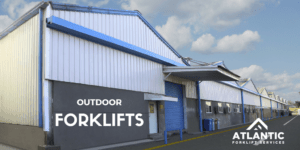Most forklifts are used indoors, or a combination of indoors and outdoors. Some, forklifts, however, spend their work lives outdoors and they need some special considerations.
Let’s start with the lot you’re working in and around. Paving matters. Ideally, a blacktop or concrete is preferred over a dirt lot that can be uneven and develop holes and irregularities that can cause a forklift to roll over. Fix these immediately as they happen.
Moving up, consider solid or foam-filled tires. Sharp objects and other debris can puncture an air-filled tire- and while the initial expense of a solid or foam-filled tires is more, at least you’ll never have to call someone out to fix a flat.
Keep the area where your forklift will be operating clear. Don’t allow employees or visitors to park in the area where your lift is to give it a wide berth to do its job.
Remember the basics when your forklift is operating on any ramps leading up and down to a loading dock. Drive the truck straight up and down the ramp and be mindful of any loads you are carrying- make sure the load is always higher than the lift on the ramp- traveling up or down (travel down in reverse). NEVER try to turn around on the ramp.
Accessorize your outdoor forklift- driving lights, flashing lights and work lights are important for illumination and safety- and make sure your reverse lights and alarm are working at all times for pedestrian safety.
In the event you will be using your lift mostly outdoors with the occasional jaunt indoors, make sure you measure your aisles to make sure you have room to maneuver. Consider the height on any entries and exits in and out of the building.
There are some considerations to keep in mind with an outdoor forklift and if you have any questions about this, our experts can absolutely help, from tires to what to think about in the lot the lift will be working in. Reach out and let us help!

